Bloco Bollywood celebrates Indian music in Brazil
By Florencia Costa SAO PAULO: Last year was a small baby step. This year, Bloco Bollywood took a big leap. Adding Indian sounds, colours and flavor to the Brazilian carnival, the street party of the Indian community in Sao Paulo last week was a huge success, with a turnout of large number of Indians, Brazilians and other nationalities. The bloco (term used for street parties) also achieved something not tried or done before: fusion of Indian and Brazilian musical forms. At 10 am on Saturday (February 25), when a mobile DJ unit with giant speakers arrived at the corner of Rua Augusta, an iconic street in the biggest city in Sao Paulo, with Matias Aires, there was just a small group of organizers standing on the pavement. Within 30 minutes, the crowd began to trickle in: Indian ladies in their colourful Punjabi dresses, men in turbans and kurtas, children with painted faces and hordes of Brazilians wearing dresses and make-up as creatively as one can imagine.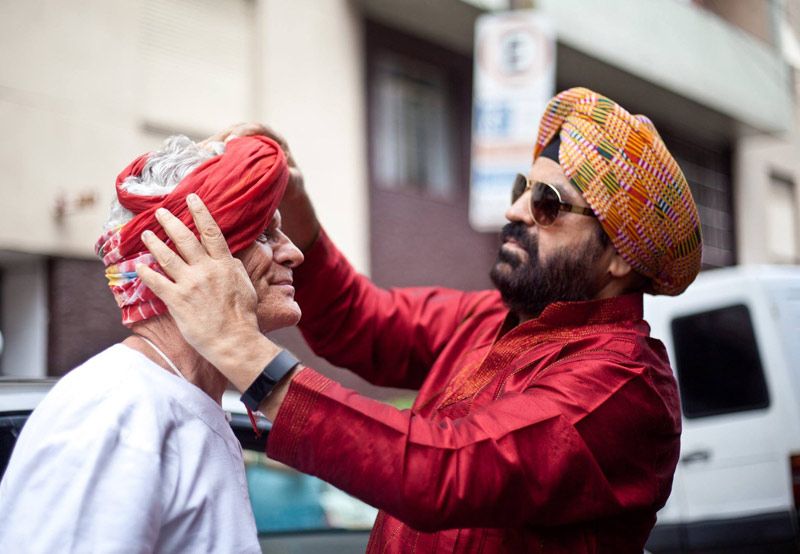
 With the crowd milling around the sound car (called carro do som in Portuguese), the DJ for the day, Mark Datysgeld, and the master of ceremonies for the day, Vijay Bavaskar, took charge by stationing themselves on a small platform on the sound car. Then the music began to flow: Punjabi numbers, Bhangra beats, Bollywood hits and the crowd began to move, swaying on their feet slowly. In an hour or so, the crowd had swelled to more than 1,000 people and the party began to rock Rua Augusta.
Sao Paulo is a city of 21 million and one can find here people from all corners of the world. It’s a melting pot of cultures and languages. The Chinese and Japanese have very strong cultural presence in the city. As the Indian community, which currently numbers around just 3,000, is growing they have felt the need to celebrate their culture in the true Brazilian fashion as well introduce the true elements of Indian music and dance in Brazil. Bloco Bollywood was conceived with this intention in 2016. The first Indian street carnival, held in February 2016, was successful in the sense that it managed to put Indian carnival on the cultural map of this vibrant city and also organize the Indian community around an typical Brazilian event they could call their own.
With the crowd milling around the sound car (called carro do som in Portuguese), the DJ for the day, Mark Datysgeld, and the master of ceremonies for the day, Vijay Bavaskar, took charge by stationing themselves on a small platform on the sound car. Then the music began to flow: Punjabi numbers, Bhangra beats, Bollywood hits and the crowd began to move, swaying on their feet slowly. In an hour or so, the crowd had swelled to more than 1,000 people and the party began to rock Rua Augusta.
Sao Paulo is a city of 21 million and one can find here people from all corners of the world. It’s a melting pot of cultures and languages. The Chinese and Japanese have very strong cultural presence in the city. As the Indian community, which currently numbers around just 3,000, is growing they have felt the need to celebrate their culture in the true Brazilian fashion as well introduce the true elements of Indian music and dance in Brazil. Bloco Bollywood was conceived with this intention in 2016. The first Indian street carnival, held in February 2016, was successful in the sense that it managed to put Indian carnival on the cultural map of this vibrant city and also organize the Indian community around an typical Brazilian event they could call their own.
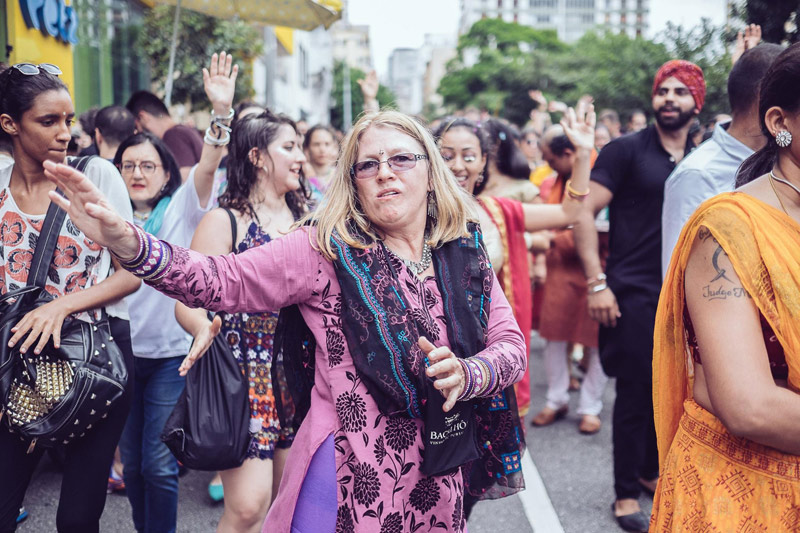
 Like last year, the event attracted members of the Indian community from Sao Paulo, Rio de Janeiro and several other cities, diplomats from the Indian Consulate and Indian dancers and musicians based here. Addressing the gathering, the Indian Consul General, Abhilasha Joshi, said, “It’s great to see Indian music, dance and culture being presented on the streets of Sao Paulo as part of the Brazilian carnival.” The Consul General thanked the organizers for a nice display of Indian music and dances in Brazil.
In general, people around the world imagine Brazilian carnival to be just the samba parade that takes place in Sambadrome in Rio de Janeiro. But that’s only a very small – and touristy – part of the carnival. The festival goes on for almost a month and its main feature is blocos – street parties organized various themes, ranging from music and culture to politics and social issues. In fact, the blocos are the main form of cultural expression in this country. Every bloco has a theme and their typical music and dance form.
Bloco Bollywood, organized by the Indian community in Sao Paulo, has now added Indian music: Bollywood and Punjabi; Indian dances and bhangra dhol beats to the carnival of the most cosmopolitan city in Latin America. In a major step in creating a fusion of Indian and Brazilian music, the Indian bloco introduced the drum band from the Institute of Physics and Astronomy of University of Sao Paulo (USP) at the their party. Called Cherateria, the band comprising 17 drummers, learned to play bhangra dhol beats with their Brazilian instruments. As they played samba and then bhangra on Rua Augusta, all feet on the street were tapping and swirling to the beautiful music.
Like last year, the event attracted members of the Indian community from Sao Paulo, Rio de Janeiro and several other cities, diplomats from the Indian Consulate and Indian dancers and musicians based here. Addressing the gathering, the Indian Consul General, Abhilasha Joshi, said, “It’s great to see Indian music, dance and culture being presented on the streets of Sao Paulo as part of the Brazilian carnival.” The Consul General thanked the organizers for a nice display of Indian music and dances in Brazil.
In general, people around the world imagine Brazilian carnival to be just the samba parade that takes place in Sambadrome in Rio de Janeiro. But that’s only a very small – and touristy – part of the carnival. The festival goes on for almost a month and its main feature is blocos – street parties organized various themes, ranging from music and culture to politics and social issues. In fact, the blocos are the main form of cultural expression in this country. Every bloco has a theme and their typical music and dance form.
Bloco Bollywood, organized by the Indian community in Sao Paulo, has now added Indian music: Bollywood and Punjabi; Indian dances and bhangra dhol beats to the carnival of the most cosmopolitan city in Latin America. In a major step in creating a fusion of Indian and Brazilian music, the Indian bloco introduced the drum band from the Institute of Physics and Astronomy of University of Sao Paulo (USP) at the their party. Called Cherateria, the band comprising 17 drummers, learned to play bhangra dhol beats with their Brazilian instruments. As they played samba and then bhangra on Rua Augusta, all feet on the street were tapping and swirling to the beautiful music.
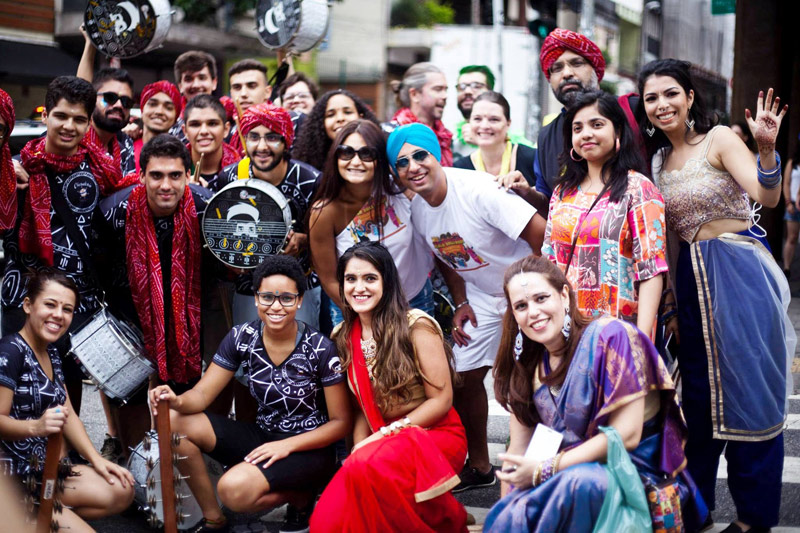 Conceived by Indian-Brazilian journalist couple Shobhan Saxena and Florencia Costa, the bloco is a result of major contribution from many people. The music for this year’s bloco was organized by Juily Malani and Nikita Kukreja. The dance groups at the party were led by Iara Ananda, an accomplished Brazilian dancer who is well versed in both Indian classical traditions as well as Bollywood; Gyaneshree Karahe, an Indian dance expert who teaches kathak at the Indian Cultural Centre basides running a Bollywood dance group; and Akshaya Bhandarkar, a young Indian dancer who has started giving Bollywood dance classes in Sao Paulo.
In a major boost for Bloco Bollywood, the group was invited to participate in a programme on blocos on TV Globos’s flagship programme, “Encontro com Fatima Bernandes”. In the programme, Juily Malani and her sister Disha alongwith Akshaya Bhandarkar performed a dance on a Punjabi number as a three-member Cherateria band led by Gabriel Costa worked on their drums. Leandra Leal, a top Brazilian actress who was a guest on the show, was so impressed with the music and dance that she expresses her desire to do a bit of bhangra and go the bloco.
Conceived by Indian-Brazilian journalist couple Shobhan Saxena and Florencia Costa, the bloco is a result of major contribution from many people. The music for this year’s bloco was organized by Juily Malani and Nikita Kukreja. The dance groups at the party were led by Iara Ananda, an accomplished Brazilian dancer who is well versed in both Indian classical traditions as well as Bollywood; Gyaneshree Karahe, an Indian dance expert who teaches kathak at the Indian Cultural Centre basides running a Bollywood dance group; and Akshaya Bhandarkar, a young Indian dancer who has started giving Bollywood dance classes in Sao Paulo.
In a major boost for Bloco Bollywood, the group was invited to participate in a programme on blocos on TV Globos’s flagship programme, “Encontro com Fatima Bernandes”. In the programme, Juily Malani and her sister Disha alongwith Akshaya Bhandarkar performed a dance on a Punjabi number as a three-member Cherateria band led by Gabriel Costa worked on their drums. Leandra Leal, a top Brazilian actress who was a guest on the show, was so impressed with the music and dance that she expresses her desire to do a bit of bhangra and go the bloco.
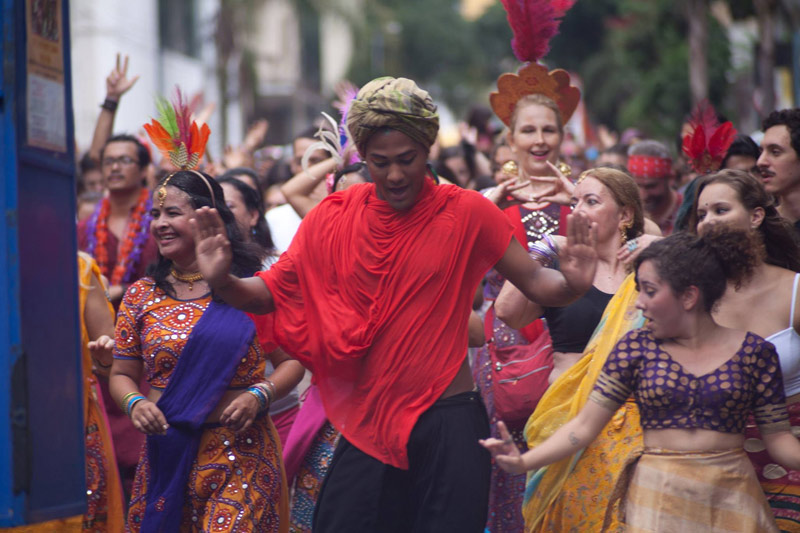 Compared to its first edition, Bloco Bollywood this year made a big splash in social media as well. The event page on facebook managed to engage more than 9,000 persons, and various videos of the party got more 30,000 views on the social media. It’s a sign that the Indian bloco is making its presence felt in Brazil.
Besides the dancers and musicians, Bloco Bollywood is actively supported and organized by a number of Indians and Brazilians in Sao Paulo. Guchi and Bani Kukreja, promiment members of the community, provided crucial support and guidance to this year’s bloco. Vijay Bavaskar, Rakesh Kanojia, Amitabh Ranjan Singh, Raju Roychwodhury and Chaitali Chatterjee played very active role in promoting the Indian street party. Biju Nair and Ajay Vettackal, two Indian businessmen based in the southern city of Curitiba continued their support to the Indian carnival like they did last year.
Compared to its first edition, Bloco Bollywood this year made a big splash in social media as well. The event page on facebook managed to engage more than 9,000 persons, and various videos of the party got more 30,000 views on the social media. It’s a sign that the Indian bloco is making its presence felt in Brazil.
Besides the dancers and musicians, Bloco Bollywood is actively supported and organized by a number of Indians and Brazilians in Sao Paulo. Guchi and Bani Kukreja, promiment members of the community, provided crucial support and guidance to this year’s bloco. Vijay Bavaskar, Rakesh Kanojia, Amitabh Ranjan Singh, Raju Roychwodhury and Chaitali Chatterjee played very active role in promoting the Indian street party. Biju Nair and Ajay Vettackal, two Indian businessmen based in the southern city of Curitiba continued their support to the Indian carnival like they did last year.
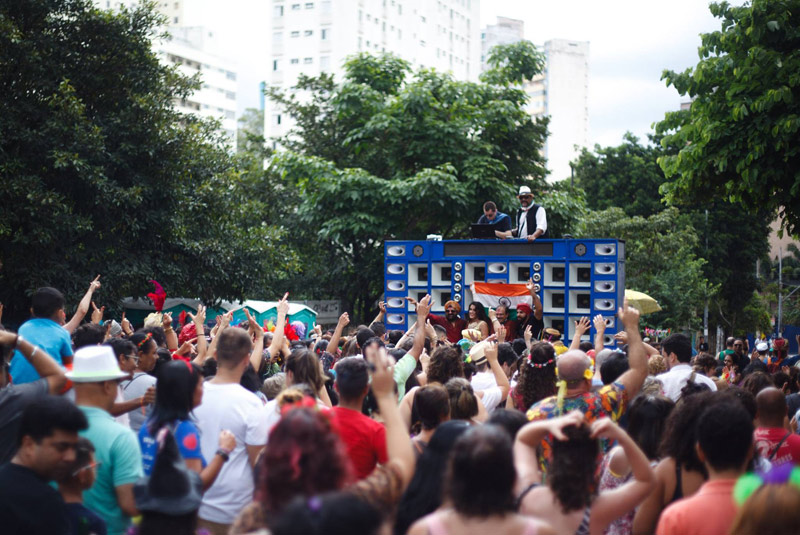 Satguru Travels Brasil, the only Indian travel company in Brazil, gave great support by providing T-shirts with the logo of the bloco. The T-shirts were sold through various Indian restaurants to raise money for the event, which is completely free and open to all.
For the first time, all Indian restaurants in Sao Paulo – Samosa & Company, Tandoor, Bawarchi, Tusli, Reet Namaste and Queen Kitchen – offered special discounts to all participants for lunch on the day of Indian carnival. As a result, after the music and dance stopped on Rua Augusta, hordes of people rushed to Indian restaurants, and the party continued till late afternoon.
(Photos by Elza Cohen, Apolo Sales, Mabbom Santos, Elisa Cordeiro, Oreste Nappi, Chaitali Chatterjee, Amitabh Singh, Patricia Magnani Pimenta, Adhemir Feliz and Florencia Costa)
READ NEXT: Brazilian journalist Florencia Costa narrates how she fell in love with India
Satguru Travels Brasil, the only Indian travel company in Brazil, gave great support by providing T-shirts with the logo of the bloco. The T-shirts were sold through various Indian restaurants to raise money for the event, which is completely free and open to all.
For the first time, all Indian restaurants in Sao Paulo – Samosa & Company, Tandoor, Bawarchi, Tusli, Reet Namaste and Queen Kitchen – offered special discounts to all participants for lunch on the day of Indian carnival. As a result, after the music and dance stopped on Rua Augusta, hordes of people rushed to Indian restaurants, and the party continued till late afternoon.
(Photos by Elza Cohen, Apolo Sales, Mabbom Santos, Elisa Cordeiro, Oreste Nappi, Chaitali Chatterjee, Amitabh Singh, Patricia Magnani Pimenta, Adhemir Feliz and Florencia Costa)
READ NEXT: Brazilian journalist Florencia Costa narrates how she fell in love with India